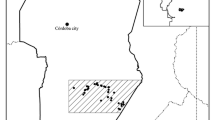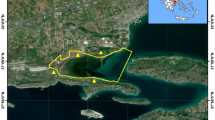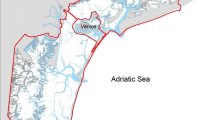Abstract
The factors regulating the distribution of dabbling and diving waterbirds were studied, taking into account habitat selection by the species in a wetland complex of 26 ponds in south-eastern Spain. Such information can be used to management and conservation of wetland threatened bird species. Direct counts and feeding-microhabitat surveys of waterbirds were conducted. The feeding-niche width and the feeding-microhabitat use, as a function of the horizontal spatial gradient in the ponds, were related to the mean size of ponds used for each species. While the more generalist birds, which usually feed close to the shore, probably had available resources in small ponds, specialists that also frequently selected central zones of the pond had proportionally more limited feeding space and, therefore, less resource availability in small ponds. The differences in habitat selection of the different species appeared to encourage their hierarchical disappearance from the wetland complex at the same rate as the ponds diminished in size (‘nested’ pattern). The results support the conservation, restoration or creation of, at least, ponds of greater size in order to preserve extensive open-water zones in the wetlands and maintain the greatest number of specialist, threatened, and area-dependent species, such as the globally endangered White-headed Duck (Oxyura leucocephala).
Similar content being viewed by others
References
Amat J.A. (1984). Interacciones entre los patos buceadores en una laguna meridional española. Doñana. Acta Vertebrata 11: 105–123
Amat J.A. (1988). Respuestas de los patos invernantes en España a diferentes condiciones ambientales. Ardeola 35: 59–70
Andrén H. (1994). Effects of habitat fragmentation on birds and mammals in landscapes with different proportions of suitable habitat: a review. Oikos 71: 355–366
Atmar W. and Patterson B.D. (1993). The measure of order and disorder in the distribution of species in fragmented habitat. Oecologia 96: 373–382
Bernert J.A., Eilers J.M., Eilers B.J., Blok E., Daggett S.G. and Bierly K.F. (1999). Recent wetlands trends (1981/82–1994) in the Willamette Valley, Oregon, USA. Wetlands 19: 545–559
Bibby C.J., Hill D.A., Burgess N.D. and Mustoe S. (2000). Bird Census Techniques. Academic Press, London
BirdLife International. (2000). Threatened Birds of the World. Lynx Edicions, Barcelona
Brown M. and Dinsmore J.J. (1986). Implications of marsh size and isolation for marsh bird management. J. Wildlife Manage. 50: 392–397
Casado S. and Montes C. (1995). Guía de los Lagos y Humedales de España. J. M. Reyero Editor, Madrid
Cirujano S., Velayos M., Castilla F. and Gíl M. (1992). Criterios Botánicos para la Valoración de las Lagunas y Humedales Españoles (Península Ibérica y las Islas Baleares). Colección Técnica. ICONA, Madrid
Craig R.J. and Beal K.G. (1992). The influence of habitat variables on marsh bird communities of the Connecticut River Estuary. Wilson Bulletin 104: 295–311
Finlayson C.M., Hollis G.E. and Davis T.J. (1992). Managing Mediterranean Wetlands and their Birds. IWRB, Slimbridge
Gibbs J.P. (1993). The importance of small wetlands for the persistence of local populations of wetland-associated animals. Wetlands 13: 25–31
Giménez E., Navarro J., Oña J.A. and Gómez Mercado F. 2003. Paraje Natural Punta Entinas-Sabinar (Almería). FloraVegetación y Ornitofauna. Monografías Ciencia y Tecnología 22. Servicio de Publicaciones (Universidad de Almería), Almería.
Gómez Mercado F. and Paracuellos M. (1995–96). Hábitats de las albuferas de Adra (Almería) recogidos en el Anexo I de la Directiva 92/43/CEE. Boletín de Ciencias del Instituto de Estudios Almerienses 14: 59–76
Gorman M.L. (1991). Ecología Insular. Vedrà, Barcelona
Green A.J. (1996). Analyses of globally threatened Anatidae in relation to threats, distribution, migration patterns and habitat use. Conserv. Biol. 10: 1435–1445
Green A.J. (1998). Comparative feeding behaviour and niche organization in a Mediterranean duck community. Can. J. Zool. 76: 500–507
Green A.J. and Hughes B. (2001). BWP Update 3: 79–90
IUCN 2004. 2004 IUCN Red List of Threatened Species. Http://www.iucnredlist.org.
Jobson J.D. (1992). Applied Multivariate Data Analysis. Volume II: Categorical and Multivariate Methods. Springer-Verlag, New York
Knutson M.G., Sauer J.R., Olsen D.A., Mossman M.J., Hemesath L.M. and Lannoo M.J. (1999). Effects of landscape composition and wetland fragmentation on frog and toad abundance and species richness in Iowa and Wisconsin, U.S.A.. Conserv. Biol. 13: 1437–1446
Larson V.L. (1995). Fragmentation of the land-water margin within the northern and central Indian River Lagoon watershed. Bull. Mar. Sci. 57: 267–277
Lawton J.H. (1996). Population abundances, geographic ranges and conservation: 1994 Witherby Lecture. Bird Study 43: 3–19
Madroño A., González C. and Atienza J.C. (2004). Libro Rojo de las Aves de España. Dirección General para la Biodiversidad (Ministerio de Medio Ambiente). Sociedad Española de Ornitología/BirdLife, Madrid
May R.M. (1975). Patterns of species abundance and diversity. In: Cody, L.M. and Diamond, J.M. (eds) Ecology and Evolution of Communities, pp 81–120. Belknapp Press, Cambridge
McCollin D. (1998). Forest edges and habitat selection in birds: a functional approach. Ecography 21: 247–260
Montes C., Oliver G., Molina F. and Cobos J. (eds), (1995). Bases Ecológicas para la Restauración de Humedales en la Cuenca Mediterránea. Consejería de Medio Ambiente (Junta de Andalucía), Sevilla
Mota J.F., Peñas J., Castro H., Cabello J. and Guirado J.S. (1996). Agricultural development vs biodiversity conservation: the Mediterranean semiarid vegetation in El Ejido (Almeríasoutheastern Spain). Biodivers. Conserv. 5: 1597–1617
Naugle D.E., Higgins K.F., Nusser S.M. and Johnson W.C. (1999). Scale-dependent habitat use in three species of prairie wetland birds. Landscape Ecol. 14: 267–276
Nilsson L. (1972). Local distribution, food choice and food consumption of diving ducks on a South Swedish lake. Oikos 23: 82–91
Nilsson L. (1978). Breeding waterfowl in eutrophicated lakes in south Sweden. Wildfowl 29: 101–110
Nudds T.D., Sjöberg K. and Lundberg P. (1994). Ecomorphological relationships among Paleartic dabbling ducks on Baltic coastal wetlands and a comparison with the Neartic. Oikos 69: 295–303
Ortega M., Casas J.J., Aguilera P.A. and Castro H. (2000). Hydrochemical characterization of wetlands in a semi-arid region of eastern Andalucía (AlmeríaSpain): a preliminary study. Internationale Vereinigung für Theoretische und Angewandte Limnologie 27: 372–377
Ortega F., Paracuellos M. and Guerrero F. (2004). Corología de macrófitos acuáticos de Andalucía Oriental. Lazaroa 25: 179–185
Owen M. and Black J.M. (1990). Waterfowl Ecology. Blackie and Son Ltd., Glasgow, London
Paracuellos M., Oña J.A., López Martos J.M., Matamala J.J., Salas G. and Nevado J.C. (1994). Caracterización de los humedales almerienses en función de su importancia provincial para las aves acuáticas. Oxyura 7: 183–194
Paracuellos M. and Tellería J.L. (2004). Factors affecting the distribution of a waterbird community: the role of habitat configuration and bird abundance. Waterbirds 27: 446–453
Parsons K.C., Brown S.C., Erwin R.M., Czech H.A. and Coulson J.C. (2002). Managing Wetlands for Waterbirds: Integrated Approaches. Waterbirds 25(Special Publication 2): 1–127
Perrins C.M. and Ogilvie M.A. (1998). The Complete Birds of the Western Paleartic CD-ROM, Version 1.0. Oxford University Press, Optimedia, Oxford
Pöysä H. (1983). Resource utilization relations between the Coot (Fulica atra) and other waterfowl species. Finish Game Res. 40: 37–48
Rey Benayas J.M., Colomer M.G.S. and Levassor C. (1999). Effects of areaenvironmental status and environmental variation on species richness per unit area in Mediterranean wetlands. J. Vege. Sci. 10: 275–280
Savard J.-P.L., Boyd W.S. and Smith G.E.J. (1994). Waterfowl–wetland relationships in the Aspen Parkland of British Columbia: comparison of analytical methods. Hydrobiologia 279/280: 309–325
Schreer J.F. and Kovacs K.M. (1997). Allometry of diving capacity in air-breathing vertebrates. Can. J. Zool. 75: 339–358
Shafer C.L. (1990). Nature Reserves. Island Theory and Conservation Practice. Smithsonian Institution Press, Washington, London
Sokal R.R. and Rohlf F.J. (1994). Biometry. W. H. Freeman & Co, San Francisco
Tellería J.L. (1986). Manual para el Censo de los Vertebrados Terrestres. Raíces, Madrid
Tellería J.L. and Santos T. (2001). Fragmentación de hábitats forestales y sus consecuencias. In: Zamora, R. and Pugnaire, F.I. (eds) Ecosistemas Mediterráneos. Análisis Funcional, pp 293–317. Colección Textos Universitarios 32. Consejo Superior de Investigaciones Científicas, Asociación Española de Ecología Terrestre, Granada
Torres Esquivias J.A. (2003). Las Malvasías Cordobesas Veinticinco Años Después. Diputación de Córdoba, Córdoba
Van Vessen J., Hecker N. and Tucker G.M. 1997. Inland wetlands. In: Tucker G.M. and Evans M.I.(eds) Habitats for Birds in Europe: a Conservation Strategy for the Wider Environment. BirdLife Conservation Series 6. BirdLife International, Cambridge, pp. 125–158.
Verboom J., Foppen R., Chardon P., Opdam P. and Luttikhuizen P. (2001). Introducing the key patch approach for habitat nerworks with persistent populations: an exemple for marshland birds. Biol. Conserv. 100: 89–101
Wettstein W. and Schmid B. (1999). Conservation of arthropod diversity in montane wetlands: effect of altitudehabitat quality and habitat fragmentation on butterflies and grasshoppers. J. Appl. Ecol. 36: 363–373
Whittaker R.H. and Likens G.E. (1973). Primary production: the biosphere and man. Hum. Ecol. 1: 357–369
Wiens J.A. (1989). The Ecology of Bird Communities. Cambridge University Press, Cambridge
Author information
Authors and Affiliations
Corresponding author
Rights and permissions
About this article
Cite this article
Paracuellos, M. How can Habitat Selection Affect the use of a Wetland Complex by Waterbirds?. Biodivers Conserv 15, 4569–4582 (2006). https://doi.org/10.1007/s10531-005-5820-z
Received:
Accepted:
Published:
Issue Date:
DOI: https://doi.org/10.1007/s10531-005-5820-z




